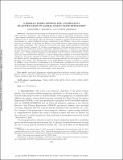A Hessian-Based Method for Uncertainty Quantification in Global Ocean State Estimation
Author(s)
Heimbach, Patrick; Kalmikov, Alex
DownloadKalmikov-2014-A Hessian-based meth.pdf (588.9Kb)
PUBLISHER_POLICY
Publisher Policy
Article is made available in accordance with the publisher's policy and may be subject to US copyright law. Please refer to the publisher's site for terms of use.
Terms of use
Metadata
Show full item recordAbstract
Derivative-based methods are developed for uncertainty quantification (UQ) in large-scale ocean state estimation. The estimation system is based on the adjoint method for solving a least-squares optimization problem, whereby the state-of-the-art MIT general circulation model (MITgcm) is fit to observations. The UQ framework is applied to quantify Drake Passage transport uncertainties in a global idealized barotropic configuration of the MITgcm. Large error covariance matrices are evaluated by inverting the Hessian of the misfit function using matrix-free numerical linear algebra algorithms. The covariances are projected onto target output quantities of the model (here Drake Passage transport) by Jacobian transformations. First and second derivative codes of the MITgcm are generated by means of algorithmic differentiation (AD). Transpose of the chain rule product of Jacobians of elementary forward model operations implements a computationally efficient adjoint code. Computational complexity of the Hessian code is reduced via forward-over-reverse mode AD, which preserves the efficiency of adjoint checkpointing schemes in the second derivative calculation. A Lanczos algorithm is applied to extract the leading eigenvectors and eigenvalues of the Hessian matrix, representing the constrained uncertainty patterns and the inverse of the corresponding uncertainties. The dimensionality of the misfit Hessian inversion is reduced by omitting its nullspace (as an alternative to suppressing it by regularization), excluding from the computation the uncertainty subspace unconstrained by the observations. Inverse and forward uncertainty propagation schemes are designed for assimilating observation and control variable uncertainties and for projecting these uncertainties onto oceanographic target quantities.
Date issued
2014-10Department
Massachusetts Institute of Technology. Department of Earth, Atmospheric, and Planetary SciencesJournal
SIAM Journal on Scientific Computing
Publisher
Society for Industrial and Applied Mathematics
Citation
Kalmikov, Alexander G., and Patrick Heimbach. “A Hessian-Based Method for Uncertainty Quantification in Global Ocean State Estimation.” SIAM Journal on Scientific Computing 36, no. 5 (January 2014): S267–S295.
Version: Final published version
ISSN
1064-8275
1095-7197